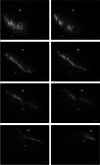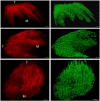Larger interface area at the human myotendinous junction in type 1 compared with type 2 muscle fibers
- PMID: 36226768
- PMCID: PMC10091713
- DOI: 10.1111/sms.14246
Larger interface area at the human myotendinous junction in type 1 compared with type 2 muscle fibers
Abstract
The myotendinous junction (MTJ) is structurally specialized to transmit force. The highly folded muscle membrane at the MTJ increases the contact area between muscle and tendon and potentially the load tolerance of the MTJ. Muscles with a high content of type II fibers are more often subject to strain injury compared with muscles with type I fibers. It is hypothesized that this is explained by a smaller interface area of MTJ in type II compared with type I muscle fibers. The aim was to investigate by confocal microscopy whether there is difference in the surface area at the MTJ between type I and II muscle fibers. Individual muscle fibers with an intact MTJ were isolated by microscopic dissection in samples from human semitendinosus, and they were labeled with antibodies against collagen XXII (indicating MTJ) and type I myosin (MHCI). Using a spinning disc confocal microscope, the MTJ from each fiber was scanned and subsequently reconstructed to a 3D-model. The interface area between muscle and tendon was calculated in type I and II fibers from these reconstructions. The MTJ was analyzed in 314 muscle fibers. Type I muscle fibers had a 22% larger MTJ interface area compared with type II fibers (p < 0.05), also when the area was normalized to fiber diameter. By the new method, it was possible to analyze the structure of the MTJ from a large number of human muscle fibers. The finding that the interface area between muscle and tendon is higher in type I compared with type II fibers suggests that type II fibers are less resistant to strain and therefore more susceptible to injury.
Keywords: confocal microscopy; injury prevention; muscle injury; muscle physiology; myotendinous junction.
© 2022 The Authors. Scandinavian Journal of Medicine & Science In Sports published by John Wiley & Sons Ltd.
Figures







References
-
- Tidball JG. Myotendinous junction: morphological changes and mechanical failure associated with muscle cell atrophy. Exp Mol Pathol. 1984;40:1‐12. - PubMed
-
- Huijing PA. Muscle as a collagen fiber reinforced composite: a review of force transmission in muscle and whole limb. J Biomech. 1999;32:329‐345. - PubMed
-
- Tidball JG. Force transmission across muscle cell membranes. J Biomech. 1991;24(Suppl 1):43‐52. - PubMed
-
- Garrett WE. Muscle strain injuries; 1996. - PubMed
MeSH terms
Substances
Grants and funding
LinkOut - more resources
Full Text Sources

